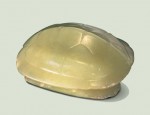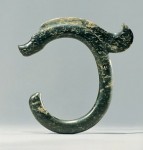Jade artifacts of the Hongshan culture
 The Hongshan culture existed about 5,000 years ago, in areas drained by the Liaohe and Xilamulun rivers in northeast China. Jade artifacts of the Hongshan culture are recognized as unique in workmanship and regional character. Most of them take the shape of animals, including turtles, fish hawks, cicadas and dragons, and are just three or four centimeters long with holes drilled through–obviously personal ornaments hanging from the belts of their owners.
The Hongshan culture existed about 5,000 years ago, in areas drained by the Liaohe and Xilamulun rivers in northeast China. Jade artifacts of the Hongshan culture are recognized as unique in workmanship and regional character. Most of them take the shape of animals, including turtles, fish hawks, cicadas and dragons, and are just three or four centimeters long with holes drilled through–obviously personal ornaments hanging from the belts of their owners.
A jade dragon, 26 centimeters long, lays coiled like alphabet C. It is too large  and heavy to be used as a personal ornament. Jade dragons similar in shape but much smaller have been identified as belonging to the Hongshan culture, inferring that the larger jade dragon could be the symbol of something supernatural that held people in awe. To be more specific, the artifact could be hung for worshipping on some special occasions, say at sacrificial ceremonies. If the inference is correct, we may say that jade artifacts were no longer used purely as ornaments in times of the Hongshan culture. Time had begun for use of jade artifacts as ceremonial objects as well.
and heavy to be used as a personal ornament. Jade dragons similar in shape but much smaller have been identified as belonging to the Hongshan culture, inferring that the larger jade dragon could be the symbol of something supernatural that held people in awe. To be more specific, the artifact could be hung for worshipping on some special occasions, say at sacrificial ceremonies. If the inference is correct, we may say that jade artifacts were no longer used purely as ornaments in times of the Hongshan culture. Time had begun for use of jade artifacts as ceremonial objects as well.